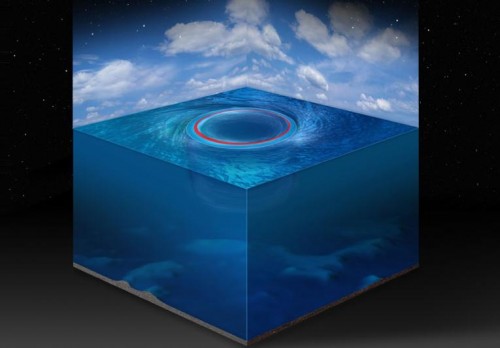The water and the fragments it collects on the way surround the vortex but do not enter inside, just as the light continues to surround the black hole in the event horizon without being able to enter or exit

Satellite photographs have recently revealed giant eddies that suck up any floating debris in the South Atlantic Ocean in a way similar to how black holes suck up the material approaching them.
The maelstroms were observed in the last three months by the physicist George Haller of the Swiss Federal Institute of Technology in Zurich and Francisco Brun-Vera of the University of Miami in Florida.
More of the topic in Hayadan:
- What is the source of the energy of the giant spirits
- Wild waves - sea monsters that man did not know
These eddies, which are 150 kilometers in diameter and move throughout the southern oceans, may also affect the Earth's climate. Their number has increased greatly in recent years and they increase the northward transfer of warm and salty water. In a warming climate, this phenomenon is expected to have an impact on increasing the melting of the glaciers in the Arctic Ocean.
"We discovered continuous belts of matter in the South Atlantic filled with the equivalent of photons that sustain black holes," Haller said.
The eddies are "mathematical equivalents" of the black holes in space, and this means that they do to the substances in water the same things that the black holes in space do to the photons of light. To describe the eddies, the researcher used Edgar Allan Poe's story from 1841 "Sliding Towards a Giant Wave".
"The edges of the vortex appear as a belt of bright spray and foam, but not a single particle of this spray slips into the mouth of the enormous vortex.
According to the physicists, not a single drop of liquid falls into the eye of the vortex when the spray surrounds its body. In space, black holes work the same way. The black hole is surrounded by balls of light in the region where gravity is so strong due to the density of the black hole, that the light surrounds it in a circle. He doesn't fall into the black hole but he can't escape it either.
To locate the eddies, the scientists analyzed satellite images of the Agulhas Current in the Indian Ocean - a current that flows along the east coast of Africa and then loops back around itself. Sometimes the loops separate and become eddies that move towards the South Atlantic Ocean and survive there for over 3 months.
Because they act as 'singular' eddies, they create a moving oases for the marine food chain, and even influence climate through the long-range transfer of salinity and heat," the study said. "They swallow every rock, oil slick or debris that comes their way and do not allow the matter to leak out of the huge whirlpool of water.
The depth of the eddies is 4 times greater than previously thought, and some reach a depth of 2,000 meters below the surface of the ocean.
to the notice of the researchers

5 תגובות
Everything is spinning, said Galeo Gallai, what's new? The genius from Vilna also described why
Can boats or ships draw or sink from the phenomenon???
Ofir
The analogy between these vortices and black holes seems far-fetched to me, too
With it being based on something the meaning is that matter caught in the vortex cannot
get out of it Regarding your questions
It is certain that the space-time is not called in vortices. An event horizon is not a point
radius and therefore the question is whether there is a radius from which matter cannot exit
out of the vortex. The movement of holes if they move is not affected by their being
Black holes but only from their mass, a black hole will move like any other mass
that the effect of gravity..
What happens in the center of the discovered vortices in terms of fiscal conditions (compared to black holes - space-time is torn?)? Is there any point from which you cannot go outside the vortex (such an event horizon)? And have black holes been observed that move through time space like the aforementioned eddies move across the oceans?
If they are so big and common, why is there no video?
The whole thing sounds fabricated to me